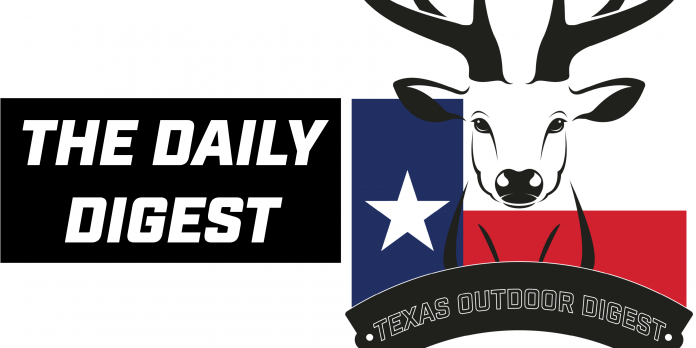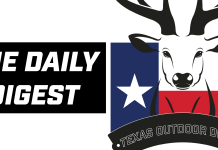The Daily Texas Outdoor Digest is sent to your inbox to keep you up to date about hunting, fishing, conservation and outdoors pursuits making headlines and going viral in the Lone Star State and beyond. It’s free, so subscribe today!
Here’s what’s worth reading today, Tuesday, July 28, 2020:
Woman swimming off Harpswell killed by shark in first such Maine fatality
A woman swimming off Bailey Island in Harpswell on Monday afternoon was attacked and killed by a shark in what one expert says is the first such fatality recorded in Maine waters. The woman has not been identified pending notification of her family.
She was swimming offshore near homes on White Sails Lane when a witness saw her being attacked by what appeared to be a shark, the Maine Marine Patrol said.
Two kayakers brought the victim and another woman to shore, where a crew of Harpswell emergency responders met them. The woman died at the scene.
The second woman, who was swimming with the victim, was not injured, said Jeff Nichols, a marine patrol spokesman.
“This is the first documented fatality ever in Maine,” James Sulikowski, a former University of New England professor and researcher who conducts shark research in Maine and locations worldwide, said in an interview Monday evening. “Shark interactions with humans are very rare in Maine.
This fall could be a busy hunting season due to coronavirus
It could be a big fall for hunters.
With many businesses and industries still being impacted by the coronavirus and the resulting shutdowns, it seems more people are turning to the outdoors to stay busy. This has led some to believe that this fall will be a busy hunting season.
Various states across the country saw a significant increase in the number of fishing licenses sold. The New Mexico Department of Game and Fish, for example, has already sold 6,000 more licenses this year than last, KRQE reports. Illinois also saw a surge in fishing licenses sold, according to The Southern Illinoisan.
As the weather turns cooler, some in the industry are expecting this trend to continue with hunting licenses, especially if lockdowns or restrictions are still in place.
For states with economies struggling due to the pandemic, this could be good news.
Toyota ShareLunker Program generates thousands of big bass offspring in 2020
The Texas Parks and Wildlife Department’s Toyota ShareLunker Program is having another outstanding year in its goal to create, bigger, better bass in Texas. After obtaining two successful spawns from one of the four 13 pound or larger Legacy Class bass loaned to the selective-breeding program in 2020, the department’s hatchery staff produced more than 28,000 fingerlings to benefit Texas public waters.
“We are pleased with the number of ShareLunker offspring produced this year, and we couldn’t have done it without the anglers who generously loaned us their 13 pound and larger bass for our selective-breeding program,” said Kyle Brookshear, Toyota ShareLunker Program Coordinator. “This generosity doesn’t just increase the lunker potential of the lakes where those fish were caught, it also helps us in our effort to convert our entire hatchery broodstock to ShareLunker offspring, which will benefit every lake in Texas.”
This year, fingerlings were produced and stocked in the 2020 Legacy Class donation lakes – including Alan Henry, Nacogdoches, and O.H. Ivie. A portion is also being held back to further our hatcheries future broodfish creation so that TPWD can stock these big-bass offspring by the millions statewide in coming years. In addition, 14,203 advanced fingerlings (excess future broodfish from the 2019 Legacy Class Spawns) were stocked in 2020 into Gilmer reservoir, Lake Pflugerville, Kurth, Lake Tyler, ponds within the future footprint of Bois d’Ark Lake and Murval.
One of the Legacy Class fish, from which there were two successful spawns, was donated to the program and will be a part of the Texas Freshwater Fisheries Center aquarium exhibits for visitors to enjoy. One fish did not spawn, but the angler has allowed TPWD to retain the fish in order to attempt to spawn it next spring. It will be returned to Lake Alan Henry at the conclusion of the spawning process. Unfortunately, two of this year’s Legacy Class donations perished due to extenuating circumstances. However, in the last five years, the program has achieved an excellent overall fish survival success rate of 86 percent during that time span.
The likely impact of Great American Outdoors Act
An expert has offered in-depth analysis on the complicated history and likely impact of the Great American Outdoors Act.
After winning final bipartisan approval in Congress last week, a bill that will pump billions of dollars into overdue repairs and maintenance of U.S. national parks is now headed to the president for his signature. It’s an unlikely success story: bipartisan support in a polarized legislature for an environmental and conservationist initiative to which the Trump administration has shown itself hostile until only recently.
Linda Bilmes, the Daniel Patrick Moynihan Senior Lecturer in Public Policy at Harvard Kennedy School (HKS), served on the bipartisan National Parks Second Century Commission and on the U.S. Department of Interior National Parks Advisory Committee from 2011 to 2017. She is also co-author (with John Loomis) of “Valuing U.S. National Parks and Programs: America’s Best Investment” and is an expert on the national parks’ complicated budgeting and chronically scarce funding.
The legislation has two main impacts. First, it establishes a National Park and Public Lands Legacy Restoration Fund that will provide up to $9 billion over the next five years to fix deferred maintenance at national parks, wildlife refuges, forests, and other federal lands, with $6.5 billion earmarked specifically to the 419 national park units.
Second, the GAOA guarantees $900 million per year in perpetuity for the Land and Water Conservation Fund (LWCF), a flagship conservation program paid for by royalty payments from offshore oil and gas drilling in federal waters. The LWCF was established in 1964 with an authorization level of $900m, but in most years Congress has appropriated less than half of this amount. The LWCF is especially important because it helps fund the four main federal land programs (National Parks, National Forests, Fish and Wildlife, and Bureau of Land Management) and provides grants to state and local governments to acquire land for recreation and conservation.
In western Colorado, wary ranchers eye wolves’ arrival and fear urban voters will introduce more
A lone black heifer wailed, wandering into white mist as night fell across a sage-studded plateau in the middle of where a wolf pack has moved into northwestern Colorado.
Rancher T. Wright Dickinson looked on, frowning, aggrieved — an arch conservative westerner whose family has run cattle here since 1885 on high country spanning three states that ranks among the last large open landscapes.
He’d turned this heifer loose for grazing through spring-fed meadows where deer, pronghorn antelope and elk roam. It’s destined to be beef for city dwellers who shop at Whole Foods but, for now, Dickinson emphasized, a moral duty obligates him to protect his herd.
“They are vulnerable,” he said. “We’re very concerned about how this relationship with wolves is going to be.”
The goodwill of ranchers like Dickinson, main tenants in still-wild parts of the West and key players in preserving open space, looms as a casualty in the push to re-establish wolves in Colorado.
Bolstering the six wolves that arrived on their own, voters concentrated in cities — Denver, Colorado Springs, Fort Collins, Boulder — are poised this November to order state officials to introduce an unspecified number more. Gov. Jared Polis has declared he’s “honored to welcome our canine friends back.”
Other Stuff That Might Tickle Your Fancy
Getting ready for the summer fishing 🎣 pic.twitter.com/XduJyY8UUd
— Lydia Raley (@Lydia_fishing) July 27, 2020
Who's with us?! 🦌🏹 RT if you agree!#whatgetsyououtdoors pic.twitter.com/G99C9tEExy
— Outdoor Channel (@OUTDChannel) July 28, 2020
Oklahoma's Keystone Lake is ground zero for record-size paddlefish! Angler Cory Watters and his son show off the 151.9 pound fish – Oklahoma's latest state and world-record paddlefish!
Full Story: https://t.co/YNgtmjbAcz via @GameAndFishMag#News #Fishing #BreakingNews #Record pic.twitter.com/v7EnCE8I5n
— Outdoor Channel (@OUTDChannel) July 24, 2020
Stay in the Know With The Daily Texas Outdoor Digest
If you haven’t subscribed yet, there’s no better time than right now (We hate spam and we won’t share your information with anyone. That’s just not cool):



















